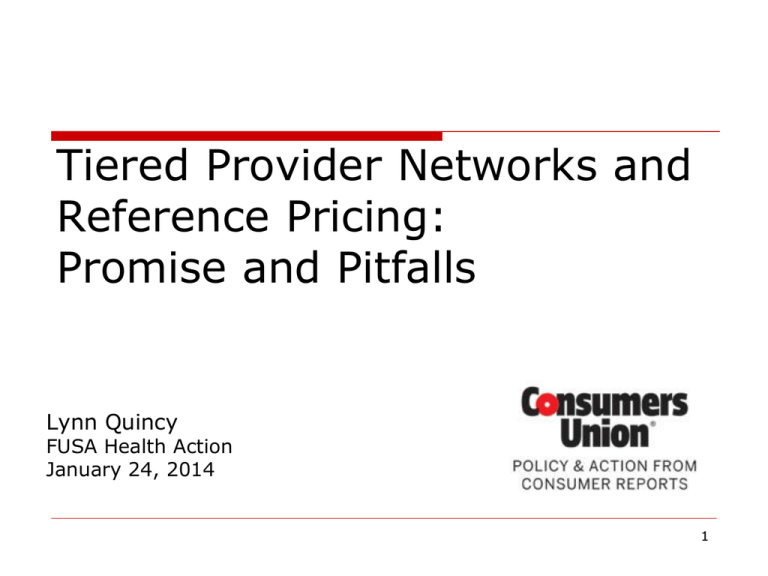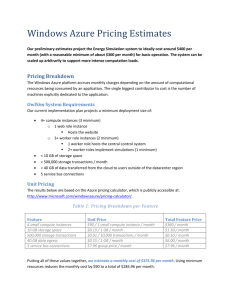Tiered Provider Networks and Reference Pricing
advertisement

Tiered Provider Networks and Reference Pricing: Promise and Pitfalls Lynn Quincy FUSA Health Action January 24, 2014 1 Tiered Provider Networks Hospitals and/or physicians grouped into tiers based on quality and cost metrics. Patient cost-sharing lowest for the “high value” tier, incenting patients to use those providers. Also known as: Value-based provider networks Select provider networks 2 Narrow Networks Only one in-network tier is offered, nominally consisting of providers that are the best value. 4 Reference Pricing To address variation in pricing, health plan identifies a cap (“reference price”) for a clinical service. Examples CalPERS: Hip Replacement $15,000 $30,000 $110,000 Safeway: Colonoscopy $848 $1,500 Source: Wilson, Private Sector Approaches to Health Care Cost Containment: A Closer Look, Consumers Union and RWJF, November 2013. $5,984 5 Reference Pricing Enrollees get a list of providers who accept the reference price Enrollees pay the balance if the provider charges more than the reference price 6 Reference Pricing: Dramatic Results After instituting reference pricing for hip/knee replacements, CalPERS experienced 20.2% decline in spending. (A small portion even accrued to enrollees!) Savings due to: price reductions from higher cost facilities greater share of procedures being conducted at “value” priced facilities Source: Robinson & MacPherson. “Payers Test Reference Pricing and Centers of Excellence to Steer Patients to Low-Price and High-Quality Providers,” Health Affairs 2012. 7 Why choose $30,000 for allowed charges? • High volume, high quality facilities with geographic dispersion were charging less than $30,000 95% percentile $74,721 5% percentile $12,588 $30,000 Source: University of California, Berkeley analysis, June 2013. Data for 2008 to 2010. Permission granted for use in this slide deck. Allowed charges for the hip or knee replacement pre- and post- implementation of value based purchasing design program 95% percentile Pre -- $74,721 Post -$40,302 Pre-Implementation $30,000 Post-Implementation Source: University of California, Berkeley analysis, June 2013. Pre-implementation data for 2008 to 2010 and postimplementation data for 2011-2012.. Permission granted for use in this slide deck. Good for Consumers? Considerations: Markets have tremendous variation in provider charges, not reflecting quality differences Consumers need relief from rising health costs Consumers believe that high cost=high quality In surveys and structured focus groups, consumers have a preference for narrower networks vs. paying higher premiums or higher cost-sharing, as long as quality isn’t affected. 10 Consumer Concerns Can consumers navigate this increased complexity? Poor consumer-facing measures of network adequacy – will a consumer know the plan features a narrow network? Do tiered/narrow networks increase “surprise” out-of-network charges? If providers are good at some things but not others, what tier do they go to? Are some networks being created with little regard for quality? 11 How Is Provider Quality Measured? National Quality Forum has endorsed 700+ provider performance measures Survey of large commercial plans shows tremendous variation in which measures are used Little research showing which measures are effective A. Higgins, “Provider Performance Measures in Private and Public Programs: Achieving12 Meaningful Alignment with Flexibility to Innovate,” Health Affairs 32, no. 8 (2013) Health Plans’ Use Of Performance Measures, By Type Of Measure. Source: Higgins A et al. Health Aff 2013;32:1453-1461 ©2013 by Project HOPE - The People-to-People Health Foundation, Inc. How Is Provider Quality Measured? Commonly used measures focus on: cardiovascular conditions, diabetes, preventive services, and patient safety What if we care about maternity? A. Higgins, “Provider Performance Measures in Private and Public Programs: Achieving14 Meaningful Alignment with Flexibility to Innovate,” Health Affairs 32, no. 8 (2013) Thank you! Please email with questions: lquincy “at” consumer.org Health cost resources available on: www.consumersunion.org/healthcare-costs 15











